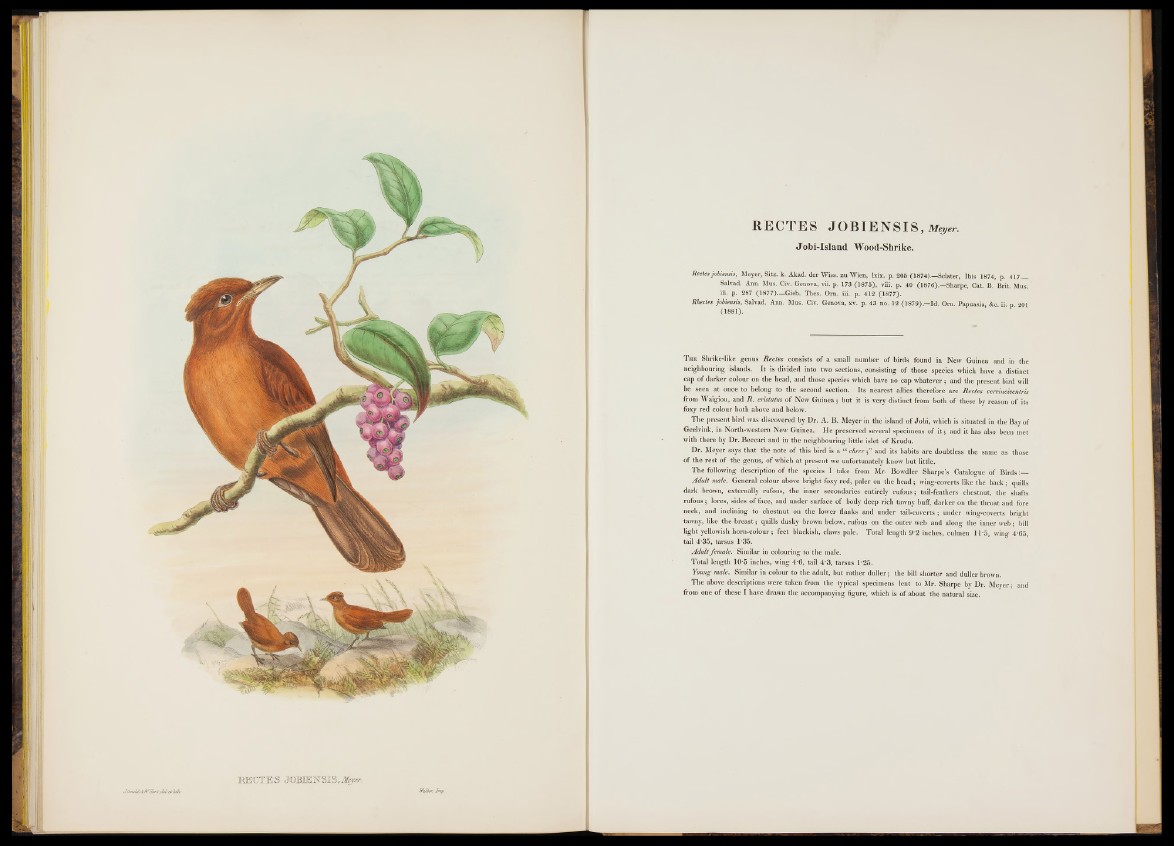
J.GvuZä/lifKBarb1(leictT i& ' JfW ter, Im p.
RECTES JOBIENSIS, Meyer.
Jobi-Island Wood-Shrike.
Rectes jobiensis, Meyer, Sitz. k. Akad. der Wiss. zu Wien, lxix. p. 205 (1874).—Sclater, Ibis 1874, p. 4 17__
Salvad. Ann. Mus. Civ. Genova, vii. p. 173 (1 8 7 5 ), viii. p. 40 (1 8 7 6 ).—Sharpe, Cat. B. Brit. Mus.
iii. p. 287 (1 8 7 7 )— Gieb. Thes. Orn. iii. p. 412 (1 8 7 7 ).
Rhedes jobiensis, Salvad. Ann. Mus. Civ. Genova, xv. p. 43 no. 12 (1 8 7 9 ).—Id. Orn. Papuasia, &c. ii. p. 201
(18 8 1 ).
T h e Shrike-like genus Rectes consists o f a small number o f birds found in New Guinea and in the
neighbouring islands. It is divided into two sections, consisting o f those species which have a distinct
cap o f darker colour on the head, and those species which have no cap whatever; and the present bird will
be seen at once to belong to the second section. Its nearest allies therefore are Rectes cervineivenlris
from Waigiou, and R . cristatus o f New Guinea; but it is very distinct from both o f these by reason o f its
foxy red colour both above and below.
The present bird was discovered by Dr. A. B. Meyer in the island o f Jobi, which is situated in the Bay of
Geelvink, in North-western New Guinea. He preserved several specimens o f i t ; and it has also been met
with there by Dr. Beccari and in the neighbouring little islet o f Krudu.
Dr. Meyer says that the note o f this bird is a “ ch rrr;” and its habits are doubtless the same as those
of the rest o f the genus, o f which at present we unfortunately know but little.
The following description o f the species I take from Mr. Bowdler Sharpe’s Catalogue o f Birds:__
Adult male. General colour above bright foxy red, paler on the head; wing-coverts like the back; quills
dark brown, externally rufous, the inner secondaries entirely rufous; tail-feathers chestnut, the shafts
rufous; lores, sides o f face, and under surface o f body deep rich tawny buff, darker on the throat and fore
neck, and inclining to chestnut on the lower flanks and under tail-coverts; under wing-coverts bright
tawny, like the breast; quills dusky brown below, rufous on the outer web and along the inner web; bill
light yellowish horn-colour; feet blackish, claws pale. Total length 9-2 inches, culmen 11*5, wing 4-65,
tail 4*35, tarsus 1'35.
Adult female. Similar in colouring to the male.
Total length 10*5 inches, wing 4*6, tail 4*3, tarsus 1*25.
Young male. Similar in colour to the adult, but rather duller; the bill shorter and duller brown.
The above descriptions were taken from the typical specimens lent to Mr. Sharpe by Dr. Meyer; and
from one o f these I have drawn the accompanying figure, which is o f about the natural size.